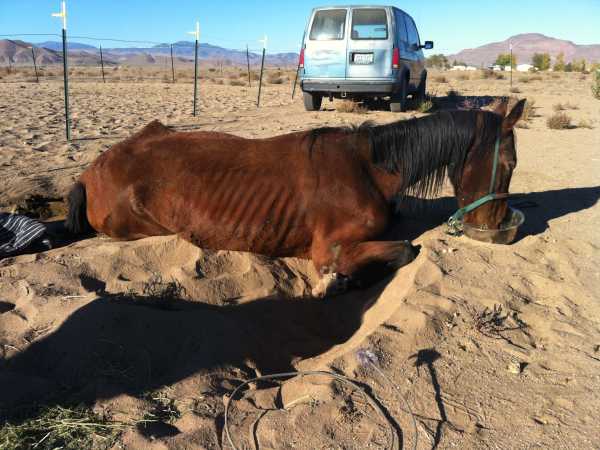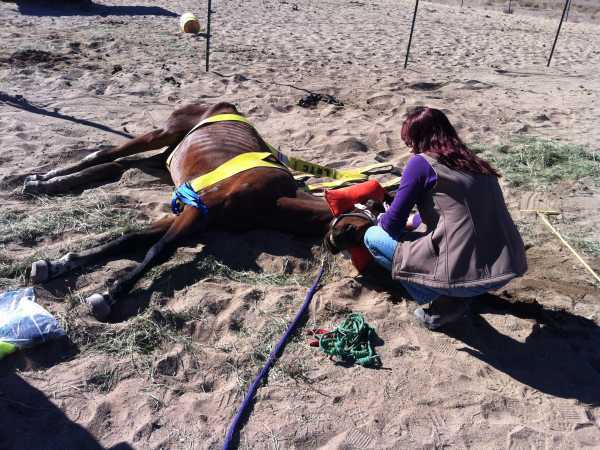LARGE ANIMAL RESCUE SKULL SESSION
|
THE MARE IS DOWN!HOW THE INCIDENT WAS RESOLVED |
|
Background.
Having literally thousands of personal horses living in the county, we regularly get calls to check on declining or debilitated horses. Over time we've learned a great deal about assessing these animals. Some times we intervene. Sometimes we attempt a rescue to better evaluate the condition of the horse. Sometimes it's best to euthanize the animal. Critical to our learning is that oftentimes what appears to be a case of simple lack of proper nourishment could actually be a symptom of an unusual causal factor. In this particular incident there are clues to be found that should help guide the decision making process with this horse.
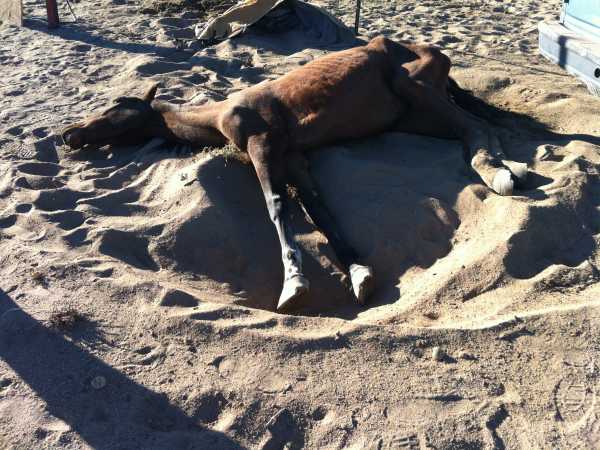
The actual incident. Some novice horse owners acquired a rescue mare off Craig's list. The horse was not in very good condition. The mare was about 12 years old. On the advice of horse-owning neighbors, they transitioned the horse from grass hay to alfalfa and provided high protein complete feeds. In spite of this diet, the horse appeared to decline. You are called out to neighbors' report of a horse down. You respond to find the situation photographed above. The mare can not quite get to her feet on her own. You initially determine that a veterinarian was called the day before but didn't arrive. (There was confusion as to the address and the "neighbor-helper" who contacted the vet subsequently turned her mobile phone off.) The mare recently has been extremely thirsty, consuming three or more times her normal water intake, even though the weather has been cooler. The mare's legs are stocked up and are oozing serum from her lower legs, particularly where skin pigment is light. The horse owner was treating these areas with Desitin and wrapping the legs. The horse's hooves were very long in the toe. (The owners' horse trimmer moved out of state and they were on a wait list for another barefoot trimmer.) The horse was discovered by her owners after leaning against a wire fence and actually falling through it. The horse could get to a sternal position but not rise on her own. In the sternal position, the horse showed good appetite and drank water heartily. (The water was metered to the horse in small quantities.) The veterinarian was contacted, a correct address given, and would be available in a few hours. (Sometimes we're lucky to get a veterinarian out on the same day out here.) Skull Session Questions
Group Feedback Check out the scene, condition and vigor of the horse, access for equipment, any obstacles, possible entanglements. Make sure the vet is responding. Get an ETA if possible. Take stock of available resources. Get protective gear (helmets, gloves, etc.) for handling the horse. Provide shade if hot and protect the down side eye. After learning of the horse's history, consider that the mare is having issues such as refeeding syndrome, potential protein issues and/or neurological issues. Horse likely should have been on high fiber, low protein feeds while recovering. Get the mare into a sternal position or roll her onto her other side. Provide upwards assist to see if the horse can stand.
Upon arrival I assessed the horse. She was reasonably alert and was interested in food and water. With assistance from the horse owner and friends, we got the horse to a sternal position, gave her small portions of water, then tried unsuccessfully to get her to stand. I called for the horse rescue team and secured a response from the veterinarian who had on the previous day been given a bad address. We rolled the horse over on her opposite side. I noticed that the horse had very long toes. Given that she would have difficulty maneuvering her feet if she could stand, I nipped her toes down while she laid on her side and we waited for the horse rescue team to arrive. A neighbor brought over a tractor with a bucket loader. The horse rescue team arrived along with the other Animal Services Officer and we rigged a vertical assist using straps from the Rescue Glide kit. We also applied a flotation device to protect her eyes.
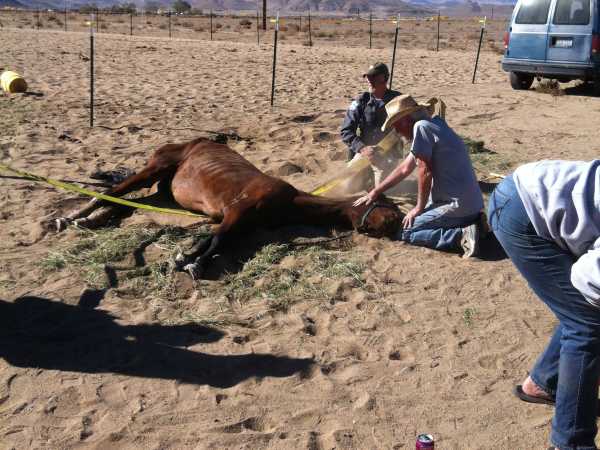
We rigged the bucket with quick releases in the event the horse panicked, applied the straps and then vertically assisted the horse. From her position in the soft sand it was not feasible to apply a standard chest strap. We had to form a neck yoke from webbing to secure the horse's chest to the front strap (to keep her from tumbling forward during the lift.)
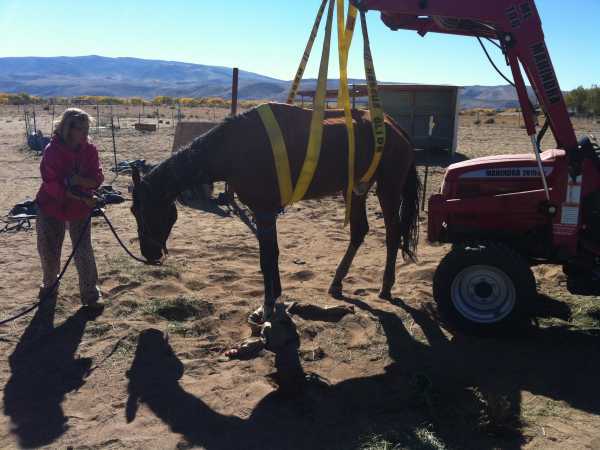
The mare was able to stand on her own and we slightly lowered the bucket so that she bore her own weight. Her level of alertness improved while she was standing.
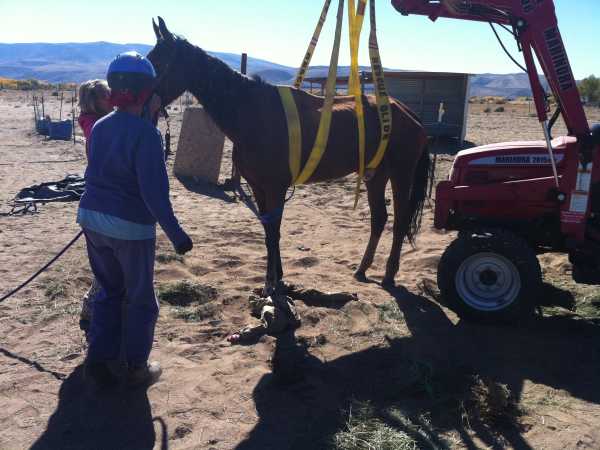
With the straps loosened (bucket slightly lowered) so as just to provide emergency support, the horse was provided hay and metered amounts of water.
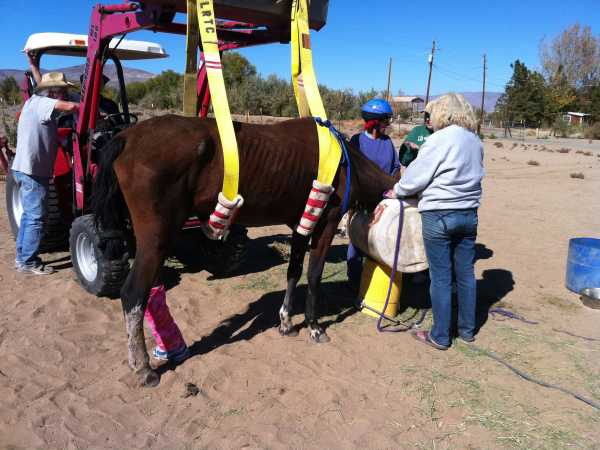
The veterinarian finally arrived and examined the horse. She apparently had a photosensitive condition that explained the stocking up of her legs and serum leaking out of her non-pigmented areas. The feeding of alfalfa only worsened this condition. Her heavy water consumption was attributed to organ failure.
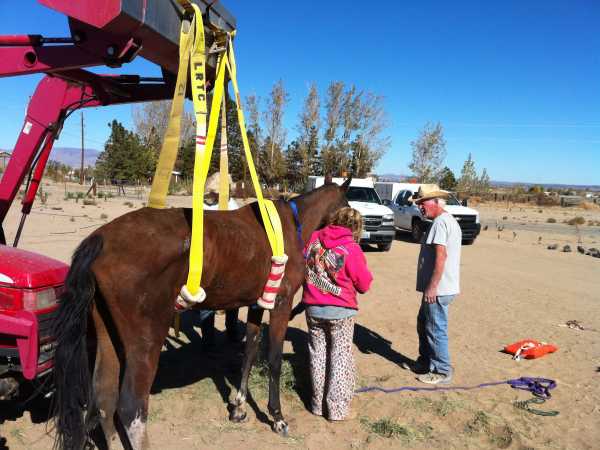
The straps were removed and the mare was able to continue standing. When asked to step forward she had no coordination and crashed to the ground. The veterinarian gave the opinion that this horse was not likely to recover and that the humane option was to euthanize her, which was done. A blood sample was taken and tested for West Nile Virus. The test came back negative. Go to Skull Session IndexReturn to the Strike Team LRTC Page |
This material is intended for the use of the Technical Large Animal Emergency Rescue (TLAER) Facebook Group. TLAER is a trademark of Technical Large Animal Emergency Rescue. |
